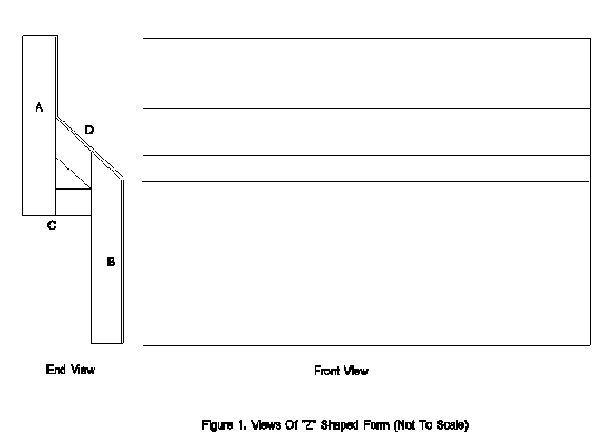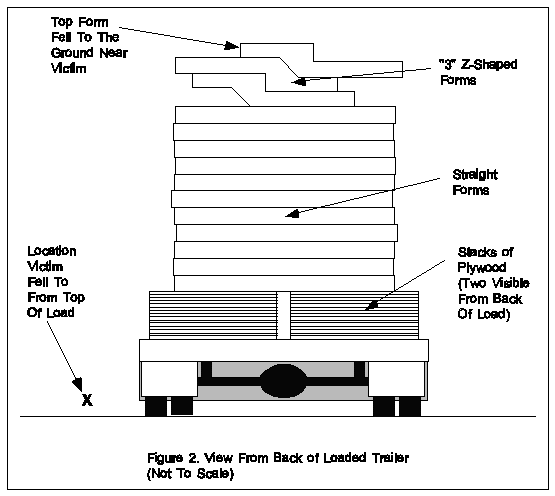Worker Dies After Falling 12 Feet From A Semitrailer
MN FACE Investigation 98MN04601
DATE: November 30, 1998
SUMMARY
A 47-year-old worker (victim) died of injuries he sustained after falling from a loaded semitrailer. The victim worked as a general field superintendent. On the day of the incident, workers were loading the trailer with forms used to make concrete bridge abutments. The victim had been standing on top of the highest form on the trailer. He was directing a forklift operator where to place the forms on the trailer while also straightening the stack of forms. The victim told the forklift operator that the load was complete and the forklift operator put the forklift away in a nearby building. Upon returning from the building where the forklift was parked, the operator observed the two highest forms rocking on top of the trailer. The forklift operator ran to the driver’s side of the trailer and observed the top form lying on the ground and the victim lying next to it. The operator then ran to the office where he told a secretary to place a 911 call. Emergency personnel arrived shortly after being called and transported the victim to a local hospital where he died later that day.
MN FACE investigators concluded that, in order to reduce the likelihood of similar occurrences, the following guidelines should be followed:
- employers should ensure that employees never stand on unstable loads; and
- employers should design, develop, and implement a comprehensive safety program.
INTRODUCTION
On August 21, 1998, MN FACE investigators were notified of an unwitnessed work-related fatal incident that occurred on August 4, 1998. The employer was a bridge construction company that employed 33 workers. The 20-year-old company built bridges in the state of Minnesota. At the time of the incident, the victim worked as a general field superintendent and previously he had worked as a foreman. He had worked for the company for 13 years. The incident occurred at the company’s place of business. A site investigation and employer interview were conducted on October 8, 1998. During MN FACE investigations, incident information is obtained from a variety of sources such as law enforcement agencies, county coroners and medical examiners, employers, coworkers and family members.
INVESTIGATION
A 47-year-old worker (victim) died of injuries he sustained after falling approximately 12 feet from a loaded semitrailer. On the day of the incident, workers were loading the trailer with straight and “Z” shaped forms used to make concrete bridge abutments. The forms were pieces of wooden framework built using 2 by 6 construction and ¾ inch plywood facing. Figure 1 shows two views of the “Z” shaped form. The end view shows that the form is approximately 5 feet tall. The height is made up of two sections (A and B) which are each approximately two and one-half feet tall. Sections A and B are joined together by sections C and D to form a Y type of shape. Sections C and D are each between 18 and 24 inches long. The front view shows a form that is 8 feet in length, but this dimension can vary from form to form. They were transported to job sites where they were used to shape abutments that supported bridge beams. Since the abutments for each structure were different, the forms are not a standard length.

In this incident, the forms loaded on the trailer (Figure 2) ranged from approximately 7 to 16 feet in length. The trailer was also loaded with three stacks of approximately twenty 4 by 8 sheets of plywood in each stack. The stacks of plywood were placed on the bottom of the load. Approximately 10 straight forms were placed on top of the plywood and the three “Z” shaped forms were placed horizontally on top of the straight forms. The irregular shape of the “Z” shaped forms made it difficult to stack them in a stable manner. The distance from the ground to the top of the load was approximately 12 feet. The load was to have been delivered to a job site the following morning.
Prior to falling, the victim had been standing on top of the highest form on the trailer. While the trailer was being loaded, he was directing a forklift operator where to position the forms on the trailer while also straightening any forms that were not lined up properly. Upon completing the load, but prior to securing it, the victim told the forklift operator to put the forklift away in a nearby building. Upon returning, the forklift operator observed the two highest forms rocking on top of the trailer. The forklift operator ran to the driver’s side of the trailer and observed the victim lying on the ground with a form lying next to him. The forklift operator then ran to the office where he told a secretary to pa 911 call. The forklift operator waited at the end of the driveway in order to direct emergency medical personnel to the scene while another worker from the office stayed with the victim. Emergency personnel arrived shortly after being called and transported the victim to a local hospital where he died later that day.
CAUSE OF DEATH
The death certificate was not available upon completion of this report.
RECOMMENDATIONS/DISCUSSION
Recommendation #1: Employers should ensure that employees stay off stacks of irregular shaped items that are difficult to stack in a stable manner.
Discussion: Stacks of irregular shaped items that are difficult to stack in a stable manner, pose a fall hazard to workers standing on them. In this incident, the irregular shape of the “Z” shaped forms prevented them from being stacked in a stable manner. If the victim had not been standing on the load containing unstable “Z” forms, this fatality may have been prevented.
Recommendation #2: Employers should design, develop, and implement a comprehensive safety program.
Discussion: Employers should ensure that all employees are trained to recognize and avoid hazardous work conditions. A comprehensive safety program should address all aspects of safety related to specific tasks that employees are required to perform. OSHA Standard 1926.21(b)(2) requires employers to “instruct each employee in the recognition and avoidance of unsafe conditions and the regulations applicable to his work environment to control or eliminate any hazards or other exposure to illness or injury.” Safety rules, regulations, and procedures should include the recognition and elimination of hazards associated with tasks performed by employees.

REFERENCES
1. Office of the Federal Register: Code of Federal Regulations, Labor, 29 CFR part 1926.21 (b)(2) U.S. Department of Labor, Occupational Safety and Health Administration, Washington, D.C., July 1, 1994.
To contact Minnesota State FACE program personnel regarding State-based FACE reports, please use information listed on the Contact Sheet on the NIOSH FACE web site Please contact In-house FACE program personnel regarding In-house FACE reports and to gain assistance when State-FACE program personnel cannot be reached.
